The 2013 MacBook Air Review (13-inch)
by Anand Lal Shimpi on June 24, 2013 12:01 AM ESTMore GPU Performance Numbers
The next set of benchmarks are taken from our 2013 Laptop Bench. Here we're comparing to HD 4000 and HD 4400, both using Acer S7s. Compared to HD 4400 the HD 5000 in Apple's 2013 MBA ends up being around 15% faster in most tests. Compared to Ivy Bridge/HD 4000 the gap ranges from lower single digits in thermally constrained environments to 25% or 40% in the best case scenarios.
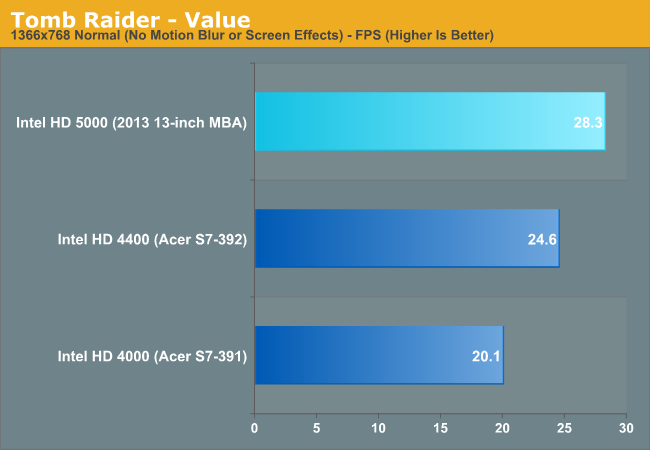

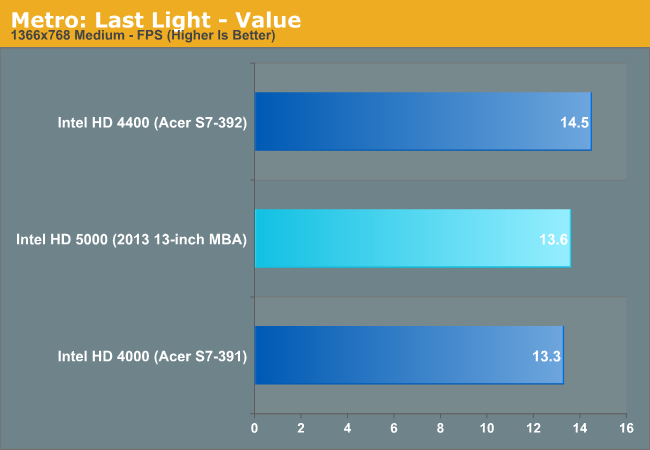
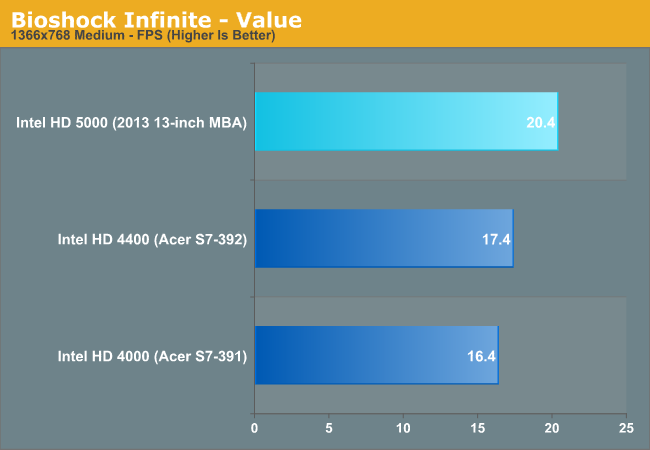
3DMark GPU Performance
We close out our look at Intel's HD 5000 performance using a historical collection of 3DMark data. The comparison gives us some more data points to characterize Intel's HD 5000. The data here is all best case scenario for HD 5000 as there are no situations where we hit thermal limits.
On average, Intel's HD 4400 ends up being 18% faster than HD 4000, while Intel's HD 5000 is 31% faster.
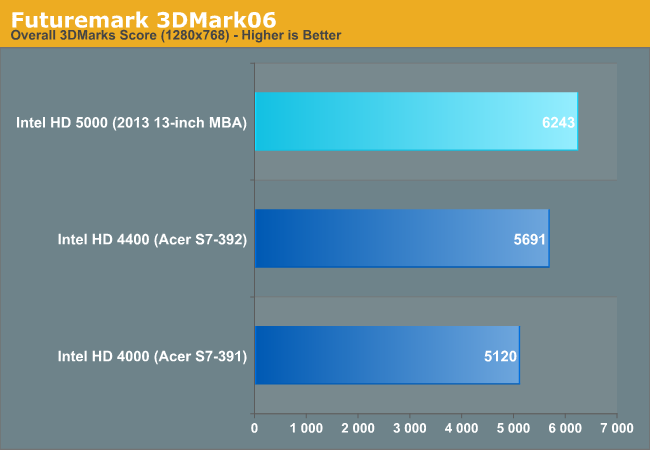
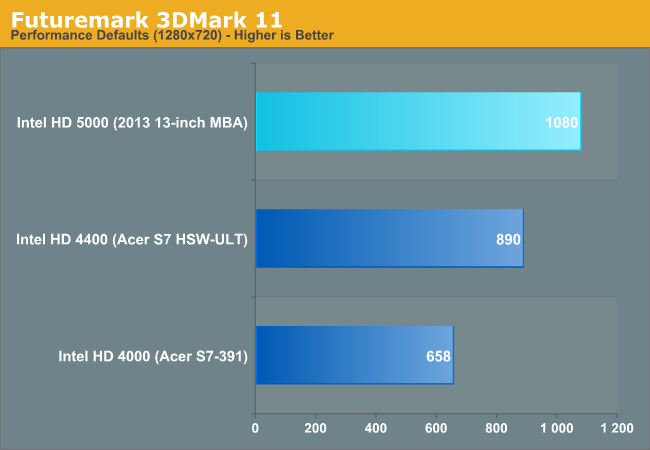
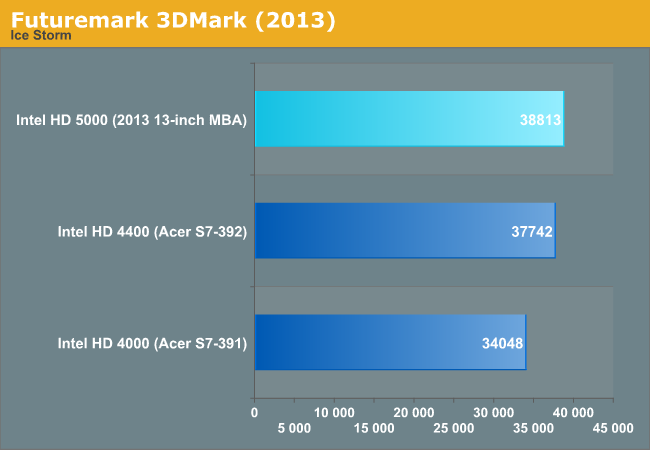
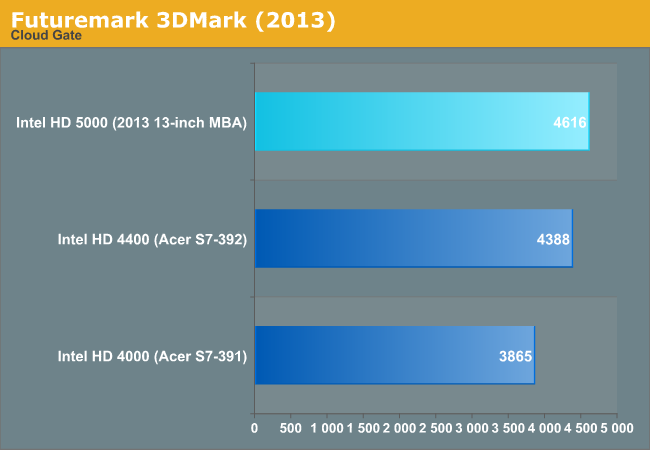
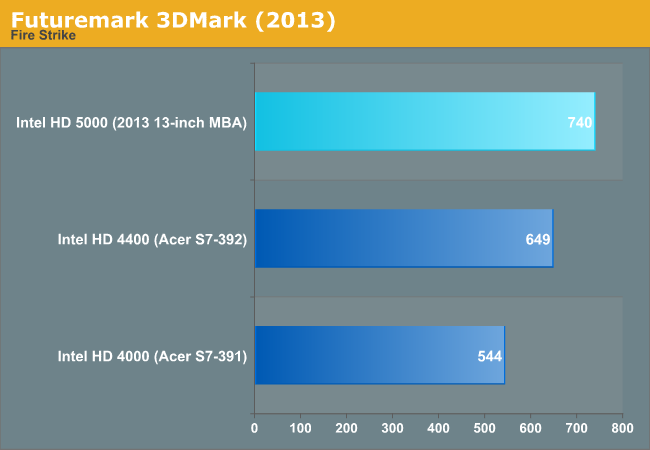










233 Comments
View All Comments
seapeople - Tuesday, June 25, 2013 - link
Brightness is pretty much the number one power consumer in a laptop like this (which is actually mentioned in the review). If you expect to run anything at 100% brightness and get anywhere near ideal battery life then you are bound to be disappointed.name99 - Monday, June 24, 2013 - link
"802.11ac ... better spatial efficiency within those channels (256QAM vs. 64QAM in 802.11n). Today, that means a doubling of channel bandwidth and a 4x increase in data encoded on a carrier"This is a deeply flawed statement in two ways.
(a) The modulation form describes (essentially) how many bits can be packed into a single up/down segment of a sinusoid wave form, ie how many bits/Hz. It is constrained by the amount of noise in the channel (ie the signal to noise ratio) which smeers different amplitudes together so that you can't tell them apart.
It can be improved somewhat over 802.11n performance by using a better error correcting code (which essentially distributes the random noise level over a number of bits, so that a single large amount of noise rather than destroying that bit information gets spread into a smaller amount of noise over multiple bits).
802.11ac uses LDPC, a better error correcting code, which allows it to use more aggressive modulation.
Point is, in all this the improved modulation has nothing to do with spatial encoding and spatial efficiency.
(b) The QAM64 and QAM256 refer to the number of possible states encoded per bit, not in any way to the number of bits encoded. So QAM64 encodes 6 bits per Hz, QAM256 encodes 8 bits per Hz. the improvement is 8/6=1.33 which is nice, but is not "a 4x increase in data encoded on a carrier".
We are close to the end of the line with fancy modulation. From now on out, pretty much all the heavy lifting comes from
(1) wider spectrum (see the 80 and 160MHz of 802.11ac) and
(2) smaller, more densely distributed base stations.
We could move from 3 up to 4 spatial streams (perhaps using polarization to help out) but that's tough to push further without much larger antennas (and a rapidly growing computational budget).
There is one BIG space for a one-time 2x improvement, namely tossing the 802.11 distributed MAC, which wastes half the time waiting randomly for one party or another to talk, and switching to a centrally controlled MAC (like the telcos) along with a very narrow RACH (random access channel) for lightweight tasks like paging and joining.
My guess/hope is that the successor to 802.11ac will consist primarily of the two issues I've described above (and so will look a lot more like new SW than new DSP algorithms), namely a central arbiter for a network along with the idea that, from the start, the network will consist of multiple small low-power cells working together, about one per room, rather than a single base station trying to reach out to 100 yards or more.
bittwiddler - Monday, June 24, 2013 - link
• The keyboard key size and spacing is the same on the 11 and 13" MBAs.• The 11" MBA is exempt from being removed from luggage during TSA screenings, unlike the 13.
• The 11" screen is lower height than most and doesn't get caught by the clip for the airplane seat tray table.
• When it comes to business travel computing, I'm not interested in a race to the bottom.
Sabresiberian - Monday, June 24, 2013 - link
One thing I would NOT like is for Apple to make a move to a 16:9 screen. I'd certainly rather have 1440x900 on a 13" screen than anything denser that was 16:9. I mean, I'm one of the guys that has been harping on pixel density and refresh rates since before we had modern smart phones (the move to LCDs set us back a decade or more in that regard), but on a screen smaller than 27", 16:9 is just bad. In my not-so-humble opinion.4:3 is better for something smaller than 17", but I can live with 16:10. :)
Kevin G - Monday, June 24, 2013 - link
Re-reading trough the review I have a question about the display: does it use panel self refresh? I recall Intel hyping up this technology several years ago and the Haswell slides in this review indicate support for it. The question is, does Apple take advantage of it?Kevin G - Monday, June 24, 2013 - link
I think that I can answer my own question. I couldn't find the data sheet for the review panel LSN133BT01A02 but references on the web point towards an early 2012 release for it. Thus it looks like it appeared on the market before panel self refresh was slated for wide spread introduction alongside Haswell.hobagman - Monday, June 24, 2013 - link
Hi Anand & all -- could I ask a more CPU related question I've been wondering about a lot -- how come the die shots always look so colorful and diverse, when isn't the top layer all just interconnects? Or are the die shots actually taken before they do the interconnects, consisting in the top 10-15 layers? Would really appreciate an explanation of this ...hobagman - Monday, June 24, 2013 - link
I mean, what are we actually seeing when we look at the die shot? Are those all different transistor regions, and if so, we must be looking at the bottom layers. Or is it that the interconnects in the different regions look different ... or ... ?SkylerSaleh - Tuesday, June 25, 2013 - link
When making the ASIC, thin layers of glass are grown on the silicon, etched, and filled with metal to build the interconnects. This leaves small sharp geometric shapes in the glass, which reacts with the light similarly to how a prism would, causing the wafer to appear colorful.cbrownx88 - Monday, June 24, 2013 - link
Please please please revisit with the i7 config - been wanting to make a purchase but have been waiting for this review (and now waiting on the update lol).